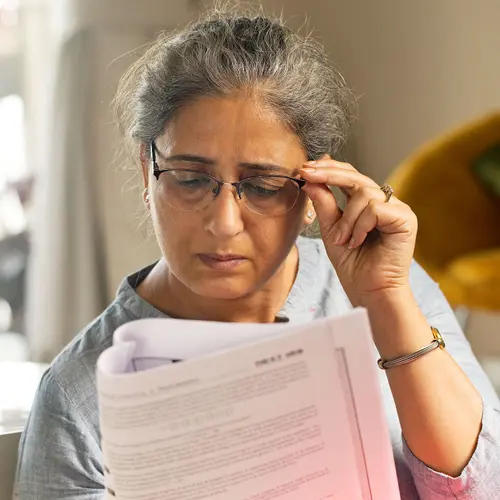Taking on the role of caregiver for a loved one can be a rewarding experience. But it also comes with stress and challenges. This is especially true when you’re a caregiver for someone with vision loss or blindness.
Geographic atrophy (GA) is an advanced form of the eye disease age-related macular degeneration (AMD). It can severely affect vision. People who have it may need extra help with everyday activities like reading and getting around the house.
So, what does it mean to care for someone with GA, and how can you also be sure to take care of yourself in the process?
Tips for Caring for Someone With GA
Learn more about geographic atrophy. One of the first ways you can help your loved one adjust to life with limited vision is to learn all you can about their illness.
Read up on what causes GA, symptoms your loved one might have, and how to help manage their symptoms. Think about talking to a counselor or joining a support group for caregivers. Organizations like the Family Caregiver Alliance, National Eye Institute of the National Institutes of Health, and Macular Degeneration Partnership also have useful information on their websites.
Connect your loved one with vision rehab services. Vision rehabilitation specialists educate those living with vision loss about ways to adapt to vision loss and maximize any remaining vision.
For instance, AMD affects vision in the center part of your eye. A vision rehab specialist will show your loved one how to take full advantage of their side (peripheral) vision. They’ll also learn about techniques and products to keep or regain their independence.
Connect your loved one to these services by contacting government and private groups assisting people with visual impairment. Or, ask your eye doctor to suggest a specialist.
Research low vision aids. These products help people with low vision make the most of their sight. As a caregiver, your loved one may need your support in choosing these tools and installing or setting them up.
Some examples of low vision aids are:
- Devices to magnify text
- Lenses that aid in long-distance vision
- Special lights
- Large-print reading materials (books, magazines, and newspapers)
- Special computers, tablets, and software
- Closed-circuit televisions (CCTVs)
- Audio devices (talking clocks, calculators, watches, navigation tools, books, and smart speakers)
- Communication devices (telephones with large buttons, special keyboards, and large screens)
Make home alterations. Also called adaptive living, these are basic changes you can make around your house to keep those with low vision safe so they can carry out daily tasks. They include things like:
- Better lighting. Think about areas of your home that need more light, like the top and bottom of a staircase, the kitchen, or where your loved one reads. The color of the lightbulb you use is important, too.
- Less glare. Put up blinds or shades on windows to lower glare and make it easier to see more clearly.
- Contrasting colors. Use dark or light contrasts in wall paint colors, outlet covers, dishes and utensils, bathroom towels, and handrails, so they stand out compared to other items around them.
- Getting organized. Keep essential items like mail, keys, and favorite foods in the same place so they’re easier to find. Create large-print labels for things your loved one uses all the time, such as cleaning and cooking supplies and medicines. Remove items they could trip over, like throw rugs.
More Tips
Other simple ways you can help someone who’s visually impaired navigate the world include:
- Communication. If you send an email, use a large font that’s easy to read. Written text should be in print instead of cursive and written with a dark-colored marker or pen. When a person with GA comes into the room, greet them, so they’re aware of your presence, and speak at a normal volume. Make it known when you’re leaving the room.
- Guiding. Instead of grasping your loved one’s arm while walking, allow them to take yours. This helps them to follow behind and expect changes ahead. Avoid leaving them alone in “free space” or not in contact with a stable object.
- Descriptions. Describe people, places, and things to aid a visually impaired person in using their sense of hearing. For example, think of a clock face when describing where food is on a plate, or explain what a seat looks like when guiding them to sit.
Caregiver Self-Care Is Important
As you take care of your loved one with GA, remember to take care of your own physical and mental well-being. Neglecting your needs can lead to burnout due to ongoing stress.
Your self-care should include:
- Look after your physical and mental health. This means getting enough sleep, staying active, and eating nutritious foods. Be sure to talk to a counselor about any concerning changes to your mental health.
- Find support. It’s tough to ask for help, but resources are available to you and your loved one, including transportation, meal delivery, and housekeeping services. There’s also in-home respite care for companionship and nursing services. Or, reach out to a friend or family member to spend time with your loved one while you take a break or run errands.
- Be kind to yourself. Take it easy on yourself, and remember you’re doing your best. Don’t feel guilty for putting yourself first sometimes and practicing self-care. In the long run, taking care of yourself will make you a better caregiver to others.

